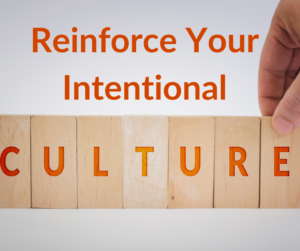Mary E. Marshall's Blog, page 4
August 25, 2022
Reinforcing Your Intentional Culture
 Once you’ve identified your culture (hopefully with three words that are easy to communicate), you need to reinforce it on a regular basis. You can use your three words to go back and fine tune the final version of your mission, vision, and values statements. Just make sure that the values expressed in those statements are “lived” and felt every day in your company. One person moving against the culture of your organization will cause problems, and, if they are allowed to continue to do so, your aligned people will leave because the organization is not living its intentional culture.
Once you’ve identified your culture (hopefully with three words that are easy to communicate), you need to reinforce it on a regular basis. You can use your three words to go back and fine tune the final version of your mission, vision, and values statements. Just make sure that the values expressed in those statements are “lived” and felt every day in your company. One person moving against the culture of your organization will cause problems, and, if they are allowed to continue to do so, your aligned people will leave because the organization is not living its intentional culture.
So, what employee rewards programs do you have to honor those who live your culture in their work? For sales, it’s relatively easy: if they sell more, their commission or bonus pay should reflect that. For internal employees, rewards (such as employee of the month or other recognition awards) should reflect very specific examples of culture success. And, if you’re building a team-based culture, recognition should be based on the performance of the whole team, not just an individual.
All of your processes and systems need to stay in alignment with your culture. If your culture exists to treat employees and customers in a humble, smart, and hungry way, for instance, do your processes reflect this? Are there things you are doing that prevent systems from conforming to your culture? Examine how things run in your organization and listen to what your employees and customers have to tell you. If you hear that something is out of alignment from more than one person, chances are they’re right. In a “smart” culture, you would encourage them to also have a solution, rather than waiting for you or a manager to fix it for them. Do your employees feel enabled to make something right for a customer? Is that in alignment with what you say your values and culture are?
Think of your company’s intentional culture as a highway that has just been paved: The road signs are clear. There is no traffic congestion. Everyone knows which side of the road to drive on. All drivers know which direction they’re headed and how to recognize when they get where they’re going. Unintentional culture is more like driving on a dirt road, with no signs, and in the wrong kind of vehicle. What are the odds these drivers know where they’re going and can actually get there? Is your organization’s culture the paved road or the dirt road? Create the road you want, or it will be created for you.
Excerpted from my book, “Putting Together the Entrepreneurial Puzzle: The Ten Pieces Every Business Needs to Succeed.” Available here on Amazon.
The post Reinforcing Your Intentional Culture appeared first on Mary Marshall // CEO Coach.
August 17, 2022
Communicating Your Intentional Culture to Your Customers
 Though more and more initial contact occurs online, often the first human interaction you have with your customers is through the people who answer your phones. It’s the rare business that never has phone contact with customers, so pay attention to this aspect of your company. One of the companies I work with changed their receptionist’s title to “Director of First Impressions.” (We’ll talk more about titles in Chapter Four, so don’t run out and change everyone’s title before you read at least that far.) Not only did that change make the receptionist feel valued, it let the customers know that they too were very important to the firm. When your employees feel important, they take their jobs more seriously and they are more likely to communicate the company’s values to the outside world. So, think about what your first impression is communicating. When you get trapped in the automated voicemail loop, how important do you feel to the company on the other end of the phone? I feel like they don’t want to talk to me, but I’ll bet nine times out of ten they have a mission and vision statement on the wall that says otherwise.
Though more and more initial contact occurs online, often the first human interaction you have with your customers is through the people who answer your phones. It’s the rare business that never has phone contact with customers, so pay attention to this aspect of your company. One of the companies I work with changed their receptionist’s title to “Director of First Impressions.” (We’ll talk more about titles in Chapter Four, so don’t run out and change everyone’s title before you read at least that far.) Not only did that change make the receptionist feel valued, it let the customers know that they too were very important to the firm. When your employees feel important, they take their jobs more seriously and they are more likely to communicate the company’s values to the outside world. So, think about what your first impression is communicating. When you get trapped in the automated voicemail loop, how important do you feel to the company on the other end of the phone? I feel like they don’t want to talk to me, but I’ll bet nine times out of ten they have a mission and vision statement on the wall that says otherwise.
I’m guessing you didn’t scrimp on your website. Does it really cost that much more to have a friendly voice answer the phone? Probably not when you do a full cost-analysis—the number of customers you keep happy will more than pay the cost of a friendly greeting when someone calls. Now, assuming you have a person to answer the phone and your three words are “hungry, humble, and smart,” what would that person have to do to communicate that culture? My guess is: pick up the phone quickly (smart), know exactly what to say (smart), be gracious when customers are upset (humble), and try to get customers to the right person to have their needs met quickly (hungry). Make sure your phone is being answered by someone who represents your culture, or you’ll be judged based on theirs.
One of my clients owns a special effects equipment manufacturing company. They are a group of very friendly, creative people. They answer the phone by saying, “Thank you for calling CITC, where cool stuff is show tough!” How can you not help but smile when you hear this? Answering the phone this way tells the caller that these people are fun and creative, and that they appreciate the call. In other words, the greeting clearly reflects the company’s culture.
Your marketing materials should also reflect your culture. Most marketing people could take a company that was “hungry, humble, and smart” and weave that culture into any product line from its packaging to its advertising. (If they don’t start with your culture, you really need a different marketing company.) What you wouldn’t want to see is an ad campaign that was misaligned with the company culture. Most products and services are available from several companies, but most cultures are unique.
Knowing that your culture is your most significant opportunity to differentiate your company from your competitors, make sure yours shows in your marketing materials and most importantly on your website. If your website frustrates your customers and potential customers, inevitably they are going to wonder how your company is going to take care of their business. We’ve all had the experience of going to a website only to encounter the “under construction” or “down for maintenance” banner, or links and tabs that go nowhere. Or the site is so difficult to navigate you can’t possibly find what you’re looking for in one or two clicks. Or how about my personal favorite: when you can’t find a phone number. That just screams, “Don’t call me!” If you prefer that people contact you via email (which is fine), make sure someone responds within twenty-four hours. If you don’t, it says volumes about what your culture is and how you’ll treat that customer in the future, if you get the chance.
Everyone at your firm (your salespeople, account managers, service people, etc.) should “touch” the customer in a way that is consistent with your culture. If you hire for culture, you won’t have difficulty training this. If you do not, you’ll have to make some changes. Every customer interaction is a reflection of your company and you. Make sure every interaction demonstrates the correct image of your company.
Excerpted from my book, “Putting Together the Entrepreneurial Puzzle: The Ten Pieces Every Business Needs to Succeed.” Available here on Amazon.
The post Communicating Your Intentional Culture to Your Customers appeared first on Mary Marshall // CEO Coach.
August 10, 2022
Communicating Your Intentional Culture to Your Employees
 If you’re just starting a company, it’s much easier to communicate your intentional culture to each new prospective recruit or employee. You can make it part of your employee handbook and orientation, and have it posted around the office in visible places. But, more than just the visuals, you need to live your values from the top down. The minute an employee sees you or the management team doing something counter to your stated values, game over. At that moment a new culture has been created and it’s called, “Lack of Integrity.” Remember the old saying that most people will give you their trust once for free, but you have to earn it back forever once it’s broken? Well, the same goes for culture within your company.
If you’re just starting a company, it’s much easier to communicate your intentional culture to each new prospective recruit or employee. You can make it part of your employee handbook and orientation, and have it posted around the office in visible places. But, more than just the visuals, you need to live your values from the top down. The minute an employee sees you or the management team doing something counter to your stated values, game over. At that moment a new culture has been created and it’s called, “Lack of Integrity.” Remember the old saying that most people will give you their trust once for free, but you have to earn it back forever once it’s broken? Well, the same goes for culture within your company.
One company CEO I worked with liked to think of himself as the “father,” and he took excellent care of his employees, creating a very patriarchal culture. Then the company hit hard times. Suddenly people were laid off, salaries were frozen, and bonuses were eliminated. Yet the employees were expected to give the same level of performance if not more. What resulted was a bunch of petulant teenagers all rebelling because father didn’t take care of them anymore. To this day that company’s culture has never returned to father-knows-best, and, because of the breach of trust, it has never performed as well either. The patriarchal culture was replaced by an “it’s not fair, distrust and entitlement” culture. The lesson here is that it doesn’t matter what your culture is (assuming, of course, that it’s legal and ethical) as long as you know what it is, you can articulate it inside and outside, and you believe in and live it.
As I’ve said, communicating your intentional culture to your employees goes well beyond stated messages. What employee programs do you have that reinforce your culture? One of my clients decided that “learning” was one of her company’s values, so she implemented quarterly programs open to all employees to learn and grow. The company also had a very generous plan for ongoing education to reward employees who took it upon themselves to enhance their skills. Like this CEO, develop opportunities within your company to allow employees to use, communicate, and “live” your culture every day.
Now back to the lobby. Please, please, make what people first see when they enter your building (or office or store or website) consistent with your culture. Remember your first date? Didn’t you want to make a good impression? You might think about this in terms of customers, but it matters for your employees too. Make sure everything you communicate both visually and verbally is aligned with your culture. Daily reinforcement contributes to employees feeling satisfied with their jobs—more so than money.
Excerpted from my book, “Putting Together the Entrepreneurial Puzzle: The Ten Pieces Every Business Needs to Succeed.” Available here on Amazon.
The post Communicating Your Intentional Culture to Your Employees appeared first on Mary Marshall // CEO Coach.
August 2, 2022
What Do You Want Your Culture to Be?
 Patrick Lencioni, author of several books on culture and teams, describes a fictional company in his book The Four Obsessions of an Extraordinary Executive: A Leadership Fable. In this company, the owners have described their culture in three words: “Hungry, humble, and smart.” They decided that anyone coming into the company needed to have drive (be hungry), needed to be respectful (be humble), and needed to be the best at what they do so they could think on their feet (be smart). The owners then looked at all their people to make sure everyone fit that culture, and they made changes with anyone who did not. They knew that one exception could take their company in a wrong direction, because one negative has more impact and influence than five positives. Next, they evaluated all of their processes to make sure those too were hungry, humble, and smart. In doing all of this they also found that their best customers fit that description as well.
Patrick Lencioni, author of several books on culture and teams, describes a fictional company in his book The Four Obsessions of an Extraordinary Executive: A Leadership Fable. In this company, the owners have described their culture in three words: “Hungry, humble, and smart.” They decided that anyone coming into the company needed to have drive (be hungry), needed to be respectful (be humble), and needed to be the best at what they do so they could think on their feet (be smart). The owners then looked at all their people to make sure everyone fit that culture, and they made changes with anyone who did not. They knew that one exception could take their company in a wrong direction, because one negative has more impact and influence than five positives. Next, they evaluated all of their processes to make sure those too were hungry, humble, and smart. In doing all of this they also found that their best customers fit that description as well.
Although this process takes place in a fictional company, the same exercise works very well in real companies. I’ve given this assignment to CEOs, and, more often than not, the ones who can describe their culture in three words and identify those traits in their employees as well as in their company’s processes are the most successful. They are the ones who continue to grow their businesses and make it look easy.
I’ve noticed a lot of firms adopting three words to describe themselves in marketing materials, and I’ve been curious about how that works inside the organization. Are those three words intentional culture or just a catchy tag line? A tag line is good for show (it looks great on marketing materials) but living the meaning of those words inside the organization as well as in your interactions with the outside world is what your company needs in order to grow. Make sure the words you choose reflect and describe your intentional culture. You can use any three words as long as you are very clear about what those words mean to you and your company. If you can’t reduce it to three words, use four or five, but keep in mind that it’s harder to create systems and processes that have more than three purposes. You might find it helpful to prioritize, and then pick the top three.
As with your mission and vision, identifying and implementing your company’s culture is essential because your lived values will drive so many of your key decisions. We’ll talk about this in more depth in Chapters Four and Five, but I’ll give an example here to illustrate the importance of this. A financial services firm I worked with was having trouble recruiting and hiring a second-in-command to eventually replace the CEO. Instead of continuing to examine applicant skills, I had the CEO come up with three words to describe his company’s culture. He decided that “accountable” (responsible for one’s actions, reliable for results), “smart” (able to think independently and of above average intelligence), and “dedicated” (devoted to getting the best results for his clients) best described his company’s intentional culture. Once he was able to define this, his vision about who that person was became clear and within three months he had located and hired the person who fit the position. Defining his company’s culture so succinctly allowed him to successfully communicate his company’s intentional purpose to a candidate and identify those same traits in the person he ultimately hired. Just as this CEO used his three-word intentional culture statement to make hiring decisions, yours can act as an overlay to everything you and your employees do within your company.
The post What Do You Want Your Culture to Be? appeared first on Mary Marshall // CEO Coach.
July 27, 2022
Intentional Culture
 Why does culture matter? Whether it’s intentional or not, every company has a culture. You can walk through the door and feel it almost the instant you step in. What does the lobby look like? What’s on the walls? Is it warm or cool? Clean or shabby? Quiet or loud? How are you greeted? Even if you don’t think you have a clearly defined culture in your company, you do. You may not be able to describe it, but I’ll bet others can and do, to your competitors as well as to your potential customers.
Why does culture matter? Whether it’s intentional or not, every company has a culture. You can walk through the door and feel it almost the instant you step in. What does the lobby look like? What’s on the walls? Is it warm or cool? Clean or shabby? Quiet or loud? How are you greeted? Even if you don’t think you have a clearly defined culture in your company, you do. You may not be able to describe it, but I’ll bet others can and do, to your competitors as well as to your potential customers.
Culture is the daily demonstration of a company’s values. Culture can be the manifestation of stated values (intentional), or the unstated but nonetheless real values that some or all of the employees share, but that are unstated (unintentional). As we discussed in the last chapter, spending a lot of time on your Intentional Purpose (values, mission, and vision) will be a waste unless that truly translates into the lived culture of your organization. Make sure they match: Culture = Lived Values.
The risk of not being intentional about your company’s culture was illustrated to me by an encounter I had with Peter Schutz of Porsche, when he came to speak to one of my TEC CEO groups about getting extraordinary results out of ordinary people. (The Executive Committee is now Vistage International.) The meeting was held at a member’s company, a software firm. As we were waiting for everyone to arrive, Peter approached me and said, “Come here, I want to show you something.” We walked down the hall and he pointed out several offices. They were messy and chaotic, with lots of personal items on display. He asked me if I thought this company had trouble sticking to plans and meeting deadlines. My answer was an emphatic “Yes!” And, in fact, those were the biggest challenges the company faced. Those offices belonged to developers who were allowed enormous flexibility in their work schedules but were not held accountable when they didn’t meet deadlines.
The owner of this company is a brilliant thinker, inventor, and idea person. He didn’t purposely set out to create a chaotic culture; it just happened as a result of his experimental personal style. While not fatal, this unintentional culture hampered his company’s growth. The business was making it because they had a product no one else had, but they had plateaued at $5 million in revenue because the owner, and consequently his team, kept reinventing the product. Because they didn’t have a culture of reasonable limits and accountability, the product was never good enough, and they continued to tinker until some clients grew frustrated and went elsewhere. Ultimately, the culture of unaccountability kept the company stuck, continuously repeating the same mistakes.
Unintended culture also presents significant problems with employees. First, without an intentional culture, it’s hard to accurately identify why someone should work for you. You’re left hiring based on skills alone, and skills by themselves don’t speak to whether or not a person will fit in and manifest your company’s values. An additional risk is that some of your employees will set the culture for you, and it’s rarely your best employees who will do that. These people are like bullies on the playground: if the playground monitor isn’t watching, they’ll set the rules and tone that everyone has to play by. A third drawback is that, in the absence of intentional culture as a unifying force, employees will head in different directions, accomplishing their own tasks in their own ways. This lack of cohesion in the team ultimately leads to lack of results.
Have you really thought about your company’s culture? Cultural confusion is more common than you might think, and a little examination should tell you if your company’s culture is preventing you from attaining the success you’d like to have. Even though some aspects or departments of your company might have a pretty defined set of values and therefore a culture, it’s essential that your entire company understand and live the same culture. No facet of your company can fully achieve its goals without the entire company adhering to the same culture. Nor can your company achieve its overall vision without everyone upholding that culture. Take a look at how your company functions: lack of communication, lack of follow through, misunderstandings, unmet deadlines, and low morale are all symptoms of a dysfunctional culture.
Excerpted from my book, “Putting Together the Entrepreneurial Puzzle: The Ten Pieces Every Business Needs to Succeed.” Available here on Amazon.
The post Intentional Culture appeared first on Mary Marshall // CEO Coach.
July 20, 2022
Mission, Vision, Values – Now What?
 During the last few weeks of blog posts, we have covered the most effective ways I have found over the years to develop Mission, Vision, and Values and why that’s so important. Next, we come to the “now what?” stage. This includes who needs to know about your Mission, Vision, Values and how you know if your company is actually “walking the talk.”
During the last few weeks of blog posts, we have covered the most effective ways I have found over the years to develop Mission, Vision, and Values and why that’s so important. Next, we come to the “now what?” stage. This includes who needs to know about your Mission, Vision, Values and how you know if your company is actually “walking the talk.”
Who Needs to Know?
In addition to your employees, who else needs to know what your Intentional Purpose (your values, mission, and vision) is? Everyone! People want to associate themselves with people who know what they stand for (values), why they exist (mission), and where they are going (vision). Getting people excited about being associated with you starts with making sure that all of your employees, customers, and partners know what your Intentional Purpose is. Make sure it is clearly communicated by everything your company does. Getting your message across clearly and energetically will help your employees, customers, and partners tell others about your company. Make telling your story fun and easy for people and they will do it for you.
How Is Your Company Living Its Intentional Purpose?
People look for congruency: do you actually walk the talk? This is where your values, and, as a result, your behavior, tell more about you and your company than any statement. Most people have pretty good BS detectors, so make sure you know how your vision is being “lived” in your organization. Living your Intentional Purpose on a daily basis means creating systems and processes that are aligned with what you believe, who you are, and where you are headed. Use your Intentional Purpose as an overlay to all decisions made within your company. And if employees know this, just think how much easier it will be for them to make good decisions. The easier you make it for employees, customers, and partners to experience your Intentional Purpose on a regular basis, the more that purpose will become reality. As a leader, it’s your job to create an environment that promotes the Intentional Purpose of your company every single day.
One CEO I worked with was revisiting his company’s mission, vision, and values. He felt it was important to include the word “fun.” When I questioned him about what the company did to fulfill the promise of “fun,” his answer was that they held a summer picnic and a holiday party. I asked if having “fun” twice a year seemed like fun. He smiled and said, “Not really.” Now, I don’t mean that you shouldn’t have fun implementing your Intentional Purpose. Just make sure that what you state as your purpose genuinely reflects what you are all about and what you want to achieve. In other words, your Intentional Purpose needs to be based, not on catchy slogans, but on a foundation of values that are true for you.
Now it’s your turn to create your Intentional Purpose. Everything else in your business will flow from the work you do in this first chapter. It’s important, so take as much time as you need. If you already have a mission or vision statement, can you remember it? Does it still make sense? Do you know the values it comes out of? Are you living it on a daily basis in your company? If not, start over. Values first.
Excerpted from my book, “Putting Together the Entrepreneurial Puzzle: The Ten Pieces Every Business Needs to Succeed.” Available here on Amazon.
The post Mission, Vision, Values – Now What? appeared first on Mary Marshall // CEO Coach.
July 13, 2022
Defining Your Intentional Vision
 Your vision is the future you are making. It’s where you want your company to be in a given time frame. Defining your intentional vision is about looking beyond the constraints of the present and seeing what could be. In developing your vision statement, try to complete this sentence: “A year from now, we will be …”.
Your vision is the future you are making. It’s where you want your company to be in a given time frame. Defining your intentional vision is about looking beyond the constraints of the present and seeing what could be. In developing your vision statement, try to complete this sentence: “A year from now, we will be …”.
The CEO of a small accounting firm I worked with could not see a vision beyond one or two staff simply because that’s the way it had always been. Not surprisingly, he didn’t have a clear intention for what he wanted for his company. As it turned out, what he really wanted was to create a firm with fifty employees in five years. But, to discover that, we first had to focus on his true intention: Was it to create a certain size firm? Was it to service a certain type of customer? Was it to provide excellent advice to businesses so they made sound decisions and maximized their tax advantage? Once we had clarified why he was in business, he could get excited about what he was doing and the where, the vision, could begin to emerge from that.
As a next step, I had him close his eyes and literally visualize his business: his desk, his office, the windows, the lobby, all the employees’ desks, the customers. The first thing he needed to do was imaginatively move past the present reality in order to ask himself: “If it were possible, what would it look like?” Kids are experts at this kind of thinking, but as adults, we inhibit our creative thinking by putting “can’t happen filters” on possibility. The New Oxford American Dictionary defines vision as “[t]he ability to think about or plan the future with imagination or wisdom.” Defining your vision, therefore, requires thinking outside of your current constraints. If money, time, and people were unlimited—if there were literally no resource constraints whatsoever—what would you create?
As soon as this CEO started thinking about what was possible, instead of what wasn’t possible, he started to develop a clear picture of where he wanted to go. A year later, he had increased his staff to ten and was still growing. True entrepreneurs are defined by their belief in possibilities—just try to talk them out of it!
Once you have the picture of what your intentional vision looks like, just as you did with your mission, test it out on a few people. Tell them about it and listen to what they say, but also watch their body language and facial expressions. Don’t get discouraged if they look at you like you’ve lost all common sense. Just sit back, listen, and ask questions. You need to be able to listen objectively so you can learn how to describe your vision in a way that creates enthusiasm and energy. This is also a good opportunity to make course corrections if necessary or to fine-tune how you deliver your message. A good friend and colleague of mine teaches leaders how to speak about themselves and their companies. Her favorite phrase for getting people to tap into their own enthusiasm about a topic is to ask what “spins your jets” about it. So, in thinking about how to communicate your intentional vision, figure out what spins your jets about it and why. When you test your vision statement on others, pay attention to what spins their jets. Is the thing that gets them excited what you want them to get excited about?
After you’ve clarified your intentional vision, and others have validated that you sound credible when describing it, it’s critical for everyone in your company to understand the vision and to decide whether or not they’re on board. You want your whole company to be excited about the vision and committed to it. Everyone in the company is, by default, in sales (no matter what role they play in the organizational scheme), and if they don’t believe in the intentional vision, they can’t sell it. Talk about your vision early and often, and make sure everyone has the words to talk about it. If they can talk about it in their own words that’s even better because then the vision means something to them personally. You want your business staffed by people who are excited about why your company exists and where it is going.
Excerpted from my book, “Putting Together the Entrepreneurial Puzzle: The Ten Pieces Every Business Needs to Succeed.” Available here on Amazon.
The post Defining Your Intentional Vision appeared first on Mary Marshall // CEO Coach.
July 6, 2022
Defining Your Intentional Mission
 The importance of really clarifying your mission is that everything else flows from it. Consider your mission the foundation of your business: a shaky foundation produces a weak business. Once you know your mission, you can begin to ask and answer important strategic questions within that framework. For instance, imagine your business one year from now, and answer each of the following questions prefaced by the frame, “If I am in service of my mission …”:
The importance of really clarifying your mission is that everything else flows from it. Consider your mission the foundation of your business: a shaky foundation produces a weak business. Once you know your mission, you can begin to ask and answer important strategic questions within that framework. For instance, imagine your business one year from now, and answer each of the following questions prefaced by the frame, “If I am in service of my mission …”:
In formulating your mission statement, start by plugging it into the following formula (you can work on making it sound elegant once you’ve clarified the basic concepts): “We exist to do X, we do it for X, and we do it by X.” One way to determine if you’re on the right track is to talk about it with other people and watch for their reactions. If you get questions and they seem excited and interested, you’re probably onto something. If they change the subject, you have a dud. Go back to square one.
Microsoft’s mission was to put a computer in every home. That’s an undeniably compelling purpose, and Microsoft largely succeeded. (They also made a lot of money along the way—intentional missions have a way of doing that.) Of course, every business is not as glamorous as Microsoft, but any business can have a compelling mission. Here are a few examples of powerful intentional mission statements:
Marriott Residence Inn: To provide our guests a home away from home.Pacific Theaters: To provide a place for people to flourish and to enhance the community.Mary Kay Cosmetics: To give unlimited opportunity to women.Aflac: To combine aggressive strategic marketing with quality products and services at competitive prices to provide the best insurance value for consumers.What’s your intentional mission?
Excerpted from my book, “Putting Together the Entrepreneurial Puzzle: The Ten Pieces Every Business Needs to Succeed.” Available here on Amazon.
The post Defining Your Intentional Mission appeared first on Mary Marshall // CEO Coach.
June 22, 2022
Defining Your Values
 While values are often tagged on after mission and vision, as I’ve just said, it’s important that you start your Intentional Purpose exercise by defining your values first. Values are the foundation of your business identity and they should inform all the decisions you make.
While values are often tagged on after mission and vision, as I’ve just said, it’s important that you start your Intentional Purpose exercise by defining your values first. Values are the foundation of your business identity and they should inform all the decisions you make.
We all have values. They may not be stated, we may not even know what they are, but we have them. Sometimes they show up in our businesses, sometimes not. But they always show up in our behaviors. Think of your values as the framework on which your identity is built. We develop our values from our upbringing, our beliefs, our role models, and from our experiences in general. One way to start thinking intentionally about your values is to think of the key experiences in your life that inform who you are and the choices you make.
When I was sixteen, I had one of those key, values shaping experiences. Shortly before returning from a year as an exchange student in Costa Rica, I learned that my father had abandoned our family of seven children. This alone was a terrible shock for a very close Catholic family, but I also learned that we had no money because my dad didn’t leave any. The oldest daughter, I arrived home to find my home very different from when I had left. Suddenly my mom was working and in a fog, we were on welfare, the church was leaving food baskets on our doorstep, and my brothers and sisters were a mess.
One of the hardest losses for me was discovering that, in my absence, my room had been given to another sibling and my few belongings had been passed on to my sisters. I was told I would have a room that used to belong to my younger brother. You can imagine what it looked like. In a big family having something all your own is a rarity. Losing all of what had been mine at once hit hard.
After I had been home about a week, my grandfather came to visit. Looking around my room, he said, “This doesn’t look like you. Would you like to change it?” Of course, I said, yes. So, my grandfather took me to the store where we picked out wallpaper and paint. For the next week, he showed me how to transform my unwanted room into something beautiful. But more important than regaining a sense of space was the quiet wisdom my grandfather imparted to me as we worked. He never said anything more negative about my father than, “I don’t understand how a man can abandon his family.” But he followed that with a key value that has become part of who I am: “It’s important to always do the right thing, no matter the cost.” The room my grandfather helped me make was wonderful, but the real gift was the lasting lesson of honor, integrity, and authenticity he taught me. What moments in your life have had that kind of lasting impact on who you are and how you make choices?
Another way to intentionally consider your values is to think about what Dave Logan refers to as “high five” and “hell no” moments. High fives are any experience that went amazingly well or resulted in great accomplishments. Ask yourself: what made those moments great? Why were they important? If you really analyze those moments, there’s probably a value in there somewhere that made it significant for you. Hell, no moments are those times when you refused to do something, or stood up for something, probably at great cost. Those moments are key because a value was being violated for you. What was it?
Before you move on to defining your mission (why you are here) and vision (where you want to be in X amount of time), give some serious thought to your values. Defining your values first is essential because they’re what keep everything else in true. Most companies will have four to eight core values, and, if they’re being intentional, they’ll know exactly what they mean. Take the time to be really clear here because words can have nuances, and it’s essential that everyone inside and outside of your company know exactly what you mean by your values statements.
Excerpted from my book, “Putting Together the Entrepreneurial Puzzle: The Ten Pieces Every Business Needs to Succeed.” Available here on Amazon.
The post Defining Your Values appeared first on Mary Marshall // CEO Coach.
June 15, 2022
Understanding Mission, Vision, and Values
 You’ve probably seen various descriptions for these three words. I suspect they’re some of the most overused terms in business, but also the least understood. Worse, although they’re the subject of much discussion, even when they are articulated, they are rarely used as the guiding principles they’re meant to be and even more rarely lived within a business’s day-to-day culture. So, let’s start from scratch. Below are my definitions of “mission,” “vision,” and “values,” followed by information and exercises on how to use them to run what I call an Intentional Business. These are the core concepts to clarify before you go any further. In other words, get the edges and corners of your puzzle in place and square before you try to figure out the rest of your entrepreneurial puzzle.
You’ve probably seen various descriptions for these three words. I suspect they’re some of the most overused terms in business, but also the least understood. Worse, although they’re the subject of much discussion, even when they are articulated, they are rarely used as the guiding principles they’re meant to be and even more rarely lived within a business’s day-to-day culture. So, let’s start from scratch. Below are my definitions of “mission,” “vision,” and “values,” followed by information and exercises on how to use them to run what I call an Intentional Business. These are the core concepts to clarify before you go any further. In other words, get the edges and corners of your puzzle in place and square before you try to figure out the rest of your entrepreneurial puzzle.
Mission usually answers the questions, Why are we here? and What do we stand for? Building from the answers to those questions, Vision is the future that will exist if you succeed in your mission. Values are the beliefs at the core of your business that act as a compass to guide behavior and decisions for everyone in the company. Let’s delve into each of these pieces in a little more depth.
MissionSuccessfully defining and pursuing your vision requires that you first understand the intention or purpose of your business. In other words: Why are you in business at all? What problem are you solving? What will be better or different as a result of your business being successful? In terms used by Dave Logan, author of Tribal Leadership: Leveraging Natural Groups to Build a Thriving Organization, what is your “Noble Cause?” Without a clear and compelling purpose, your business might survive, it might even be successful, but your progress will be accidental. Just think how hard it would be to build a car if you didn’t know what the pile of parts was supposed to do when you were done. What are the odds you would build a functioning machine? So, as you read further, take some time to think hard about your mission. Ask yourself: if my business didn’t exist, what would be missing in the world? What problem would not be solved? Who would not be served?
VisionGrowing out of a clear and intentional mission, your vision is not just a statement on the wall; it’s the future everyone in your company is working toward. If your business were to succeed beyond your wildest expectations in its first year, what would that look like? What would years two and three look like?
ValuesVision questions are important, and, in some ways, they are the fun ones to ponder because they require you to imagine your company’s success. However, before you can clearly define either your mission or your vision, you have to answer the most important question of all: what are your values? As the leader, what do you stand for? What are your core values? What principles was your company founded on? What are the intolerables in your business? There are no right or wrong answers to these questions because your values belong to you.
Excerpted from my book, “Putting Together the Entrepreneurial Puzzle: The Ten Pieces Every Business Needs to Succeed.” Available here on Amazon.
The post Understanding Mission, Vision, and Values appeared first on Mary Marshall // CEO Coach.



